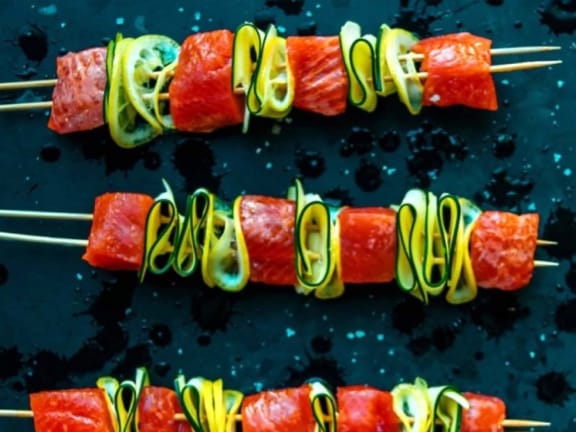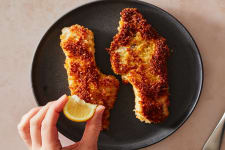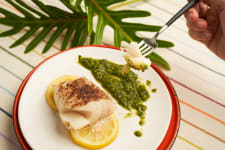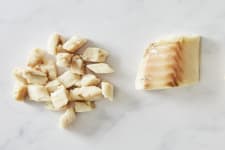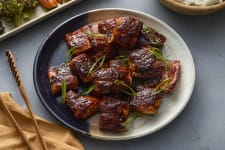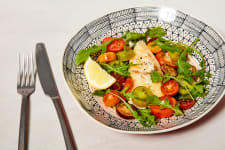Scraping off an overdone fillet of fish from your grill, losing half of your precious meal in the process, is practically a rite of passage if you’re new to cooking wild Alaskan seafood in the great outdoors. But it doesn’t have to be this way.
Whether you’re a grill master in training or an old hand who has been scarred by less-than-stellar experiences of grilling seafood, these 8 open-flame cooking tips are going to be game-changers for you this summer:
Don’t Skip the Prep
Make sure you pat your seafood dry before putting it onto the grill: Skipping this step could lead to some epic fails. That’s because too much moisture will get in the way of caramelization, instead causing the points of contact to steam rather than pick up beautiful grill marks — and your meal will be much more likely to stick to the grate of the grill. Regardless of whether you’re putting on a marinated fillet or something that has been seasoned with dry ingredients, it’s essential that you pat your meal down with a paper towel or absorbent tea towel to soak up any excess juices before cooking it.
Additionally, before introducing anything to a hot grill, you’ll also want to get your grill grate primed and ready, as we explain in our post about how to grill a perfect fillet of halibut. When the grill is nice and hot, give the grate a good scrub with a wire brush to remove the burnt-on bits from meals past, then lightly coat the grates with vegetable oil. It’s time to start cooking!
Citrus Bed
This idea from The Kitchn is a two-for-one trick for grilling a fillet of fish, especially if you’re cooking something without skin.
Thinly slice your citrus of choice and arrange the slices onto the hot grates of your grill: You’re essentially making a juicy, aromatic bed for your seafood. This puts a barrier between your fish and the grill so there’s zero chance of a fillet sticking to it and falling apart, all the while imparting the caramelized flavor of grilled citrus to your meal.
Skin Side Down
If skin-on fish fillets are on the menu, you’ve got a built-in layer of protection that will keep your meal from sticking to the grill. Whether you’re making sablefish or sockeye salmon, start it skin side down, and resist the urge to move the fillet until it’s ready to be flipped; the skin will naturally begin to pull away from the grill once its fats caramelize, making it easier for you to handle.
Note: as long as your fish is cooked to your desired doneness, you don’t even need to flip it at all — just carefully work your spatula beneath the skin and move your fish to a serving platter.
Add a Layer of Mayo
It might sound a bit strange, but coating your seafood in a thin layer of mayo is an effective way to prevent it from sticking to the grill, making it one of the best grill tricks to have in your back pocket. Mayo also enhances browning, and supposedly helps to keep things from drying out, giving your wild Alaskan seafood the treatment it deserves.
Don’t worry, if you’re not a fan of mayo, you won’t be able to taste it once the seafood is cooked. This handy trick has been embraced by grillmasters in the know, not just for fish, but for meats and veggies as well.
Banana Leaf Parcels
Gorgeous and summery, wrapping up your seafood in a lush green banana leaf helps to keep the juices in, adds a subtle hint of tropical flavor, and also makes it so that you don’t have to stress about flipping a fillet of fish and having it stick to the grate. Whatever is wrapped into the leaves will steam while picking up some aromas from the grill.
Look for recipes with flavors that would be complemented by these leaves, like this grilled fish with habañero beurre blanc from The Los Angeles Times and Bon Appetit’s recipe for Yucatecan-style fish — cod and halibut work perfectly for both.
Corn Husk Wrap
Similar to the banana leaf trick, using corn husks to wrap up your fish for the grill eliminates the risk of having your fillets sticking to the grate, steaming it and imparting a light, sweet corn flavor. This Chowhound recipe for grilled halibut is served with a complementary corn salsa, while Food Republic’s recipe for grilled salmon is dressed with a simple sprinkling of herbs. Sockeye works better than coho
Wood Plank
Using a cedar plank on the grill keeps your fillet protected from the direct heat while also giving your meal that mouthwatering flavor of smoke. Wild salmon is a classic fish to prepare on a wood plank, and makes for a beautiful presentation when done. But you can use whatever fillet of fish you like, or even scallops.
Food & Wine suggests glazing your fillets of wild salmon in a mustard and dill sauce. The publication’s recipe doesn’t give a measurement for how much sugar to use in this sauce, so start with a teaspoon and add more to sweeten to taste; the sugar will caramelize under the heat of the grill, creating a delicious glaze. Also, since this recipe was written for a large fillet rather than individual portions, you’ll want to check on your salmon sooner — smaller portions cook faster than one large one.
En Papillote
Grilling a fillet of white fish in a pouch of parchment paper, en papillote, is a classic French technique that makes grilling a cinch. Because this pouch is sealed, you have the opportunity to add in a splash of liquid that will in essence poach the fish.
This recipe from Serious Eats uses lemon and herbs as its flavor profile, but don’t limit yourself! You could fill your pouch with some curried coconut milk and cilantro, white wine and slivers of garlic, soy sauce and sliced scallions… the combinations are up to you.
